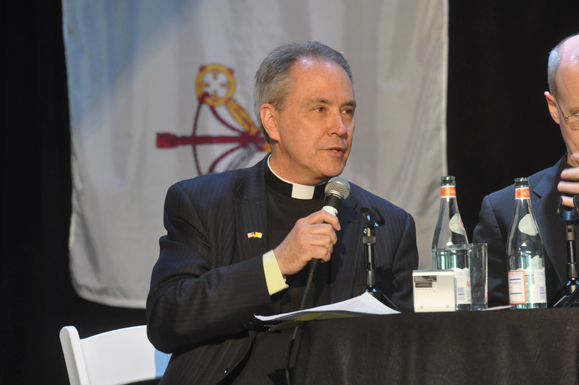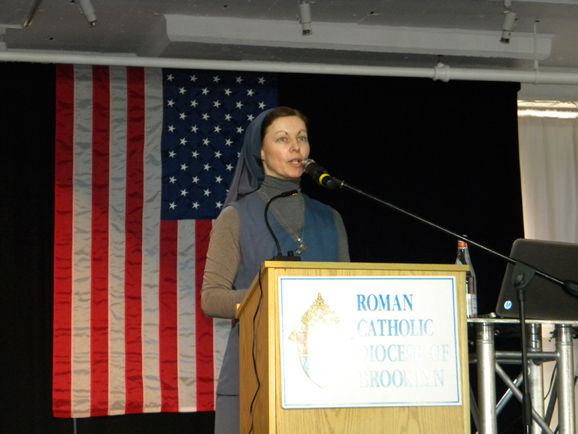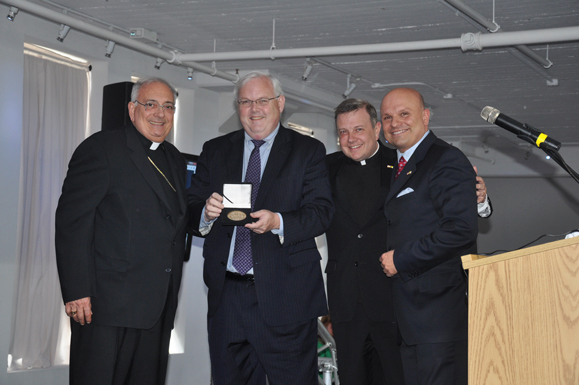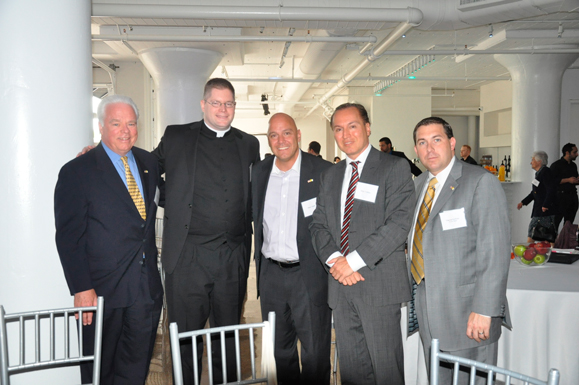Church Learning Language of Apps, Tweets,
Instagram and Websites

It was a multimedia festival, with cameras rolling, notebooks being filled and tweets being sent out, as the diocese marked its 22nd annual celebration of World Communications Day May 17 at Studio Square, Astoria.
More than 175 priests, parish representatives and diocesan employees involved in the communications ministry were in attendance at a day of workshops that focused on the Church’s adaptation to new social media.
At a luncheon, two noted journalists were honored. William McGurn, editorial page editor of The New York Post, was presented the St. Francis DeSales Distinguished Communicator Award. Bishop Nicholas DiMarzio also bestowed the St. Clare Award for Outstanding Family Entertainment on Msgr. James Lisante, the Rockville Centre, L.I., priest who hosts the TV interview show, “Close Encounter.”
McGurn, who was born in Brooklyn and started his education at Our Lady Help of Christians school, Midwood, maintained that the Church is living through a time when its beliefs are being mocked and ridiculed. But he said, “we make a huge mistake when we try to make the faith fashionable” in order to accommodate the greater society.
“The Catholic Church knows ultimately that the promises of this world are illusionary,” said McGurn, and the Church should not water down its message to make it appear fashionable.
Love and truth, he said, are at the heart of the Church’s message, and while they sometimes appear to be unfashionable, they are what gives power to the Church’s message.
In accepting his award, Msgr. Lisante said that the media provides “a wonderful opportunity to show people the beauty of faith. We need to use it and use it well.”
He said that if St. Paul were alive today, he would be using all the new social media to supplement his letters to the various Christian communities.
To Tweet or Not To Tweet
Sister Helena Burns, D.S.P., in her talk, Being Catholic in a Digital World, said, “We are both Catholic and digital. The question today is to tweet or not to tweet.”
She explained that “young people today are all about the quality of media. This is not something shallow; they want to produce something beautiful.”
Sister Helena said older generations were more willing to overlook the way a message is presented, giving a chance to Catholic films that were not of the best visual quality. However, she said, modern youth believe that if the presenter did not put effort into the product, then it is not worth the attention. Therefore, using media poorly can actually hurt the message, she said.
Nonetheless, this is not an excuse to be afraid of media, Sister Helena said. Instead, church leaders should hire and engage young people and professionals in the production of media.
It is the responsibility of the Church to guide those evangelizing online, she said. The Church has published documents encouraging responsible use of the Internet and developing media literacy.
“The Church is called to be an active listener,” she said. “We have to let the face of Jesus shine through the Internet.”
The online world is yet another gift from God, she said, referencing Pope Pius XII’s 1957 encyclical letter Miranda Prorsus, and the Pastoral Instruction on the Means of Social Communication, published in 1971.
“The Church sees these media as ‘gifts of God’ which, in accordance with His providential design, unite men in brotherhood and so help them to cooperate with his plan for their salvation,” the letter stated.
The Vatican also released a statement in 2002 confirming that the Internet falls under the media mentioned in this quote.
Keys to a Great Parish Website
The second presentation of the day featured Josh Simmons, founder and CEO of eCatholic, and Carson Weber, founder and CEO of CarsonW, Inc., speaking about the importance of a parish website.
The duo agreed that the Church’s ministry does not rest, so having a well-maintained parish website can be used as an integral tool for evangelization.
Simmons, whose company eCatholic is the largest provider of Catholic websites in the country, discussed the “Five Ways To Creating a Great Parish Website.” They are: Create a Plan, Beautiful Design, Great User Experience, Engaging Content and Beyond the Domain.
“Your website is an opportunity to inform people of what is going on in your parish but also to inspire them to want to come,” Simmons said. “Ultimately, this is going to lead to more active participation in your mission.”
Simmons said that great parish websites are clear, consistent and reflect the brand of the parish. They are also current and include the various forms of social media to spread the message.
Weber expanded on Simmons’ comments in that a parish website must be maintained for it to be effective. He said the mission of a parish website should be to evangelize and “to introduce people to the mission of Jesus Christ and His bride the Church.”
Weber said that while the parish website should not be overly fancy, it should incorporate the latest forms of multimedia to engage the audience. Video, blogging and podcasting are all user-friendly methods to capture the audience’s attention, he said.
Weber also said that parish websites should be mobile friendly. He said that since everyone is constantly on their mobile phones these days, the parish website must adapt to the changing times. The website is live 24 hours a day, seven days a week and 365 days a year, so it must be always updated with the latest content.
Weber encouraged attendees to invest the time to learn about new forms of technology. “You can do stuff really cheap and really quickly if you know what you’re doing,” he said.
Using Media Creatively
In his talk, New Media and the New Evangelization: Spreading Catholicism in a Digital Age, award-winning Catholic writer and blogger Brandon Vogt discussed ways to “proclaim the Gospel, not just from the rooftops, but from the laptops” using media in creative ways.
Vogt began by examining the Church’s renewed emphasis on evangelization and recognition of mass media’s value in transmitting the Good News, starting with the Second Vatican Council and Evangelii Nuntiandi and through to the present-day with Pope Francis’ launch of the MISSIO app.
Unlike evangelization efforts of yesteryear, in which priests and religious converted the unchurched in remote areas, Vogt said the “new” evangelization has new agents, aims and context. Today, the laity takes a leading role in renewing faith among fallen-away Catholics by using modern means to challenge social relativism and secularism.
YouTube, Twitter and text messaging “have revolutionized the ways that we communicate,” he said, because they have changed how “we understand, perceive and discuss information.”
New media tools “offer a profound opportunity” to send any message across the world – easily, quickly and virtually free, he noted.
To evangelize effectively with new media, Vogt suggested being grounded in the catechism; literate in new media; reflecting faith in social networking; engaging culture and being present where people are, i.e., the Internet.
No Medium Beneath Us
All of these ideas converged during a panel discussion between author Father James Martin, S.J., and Matthew Warner, founder of Flocknote, about how parishes can better use their websites and the new media. It was moderated by Msgr. Lisante.
Father Martin pointed out that Jesus used the medium of His day when He preached in parables.
“If it wasn’t beneath the Son of God to use the story, we shouldn’t be afraid of using the means available to us. Jesus spoke to people using the medium they could understand,” said Father Martin.
He explained that St. Paul used letters. The saints wrote books. Popes issued encyclicals. “No medium should be beneath us,” said Father Martin.
Warner said that the difference today is that the world is transitioning from a one-way to a two-way form of communication.
He recommended that parishes use their websites to build a dialogue with parishioners. “It’s about building relationships,” he explained.
At the same time, the speakers recognized that opening up communication could lead to hateful comments and ad hominem attacks. They urged that charity be the guideline and that moderators be vigilant about what appears on the sites.
Father Martin added that he has been surprised how many people are on Twitter, which restricts a message to 140 characters.
“Interestingly enough,” he pointed out, “each of the Beatitudes is under 140 characters. It’s surprising to see how many people respond to a 140-character homily.”
The World Communications Day program was hosted by the DeSales Media Group, parent company of The Tablet, NET-TV and Catholic Television Network.
Contributing to this story were Marie Elena Giossi, Jim Mancari, Ed Wilkinson and Antonina Zielinska of The Tablet staff.





